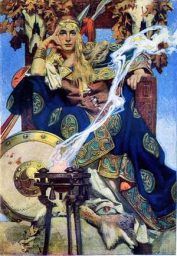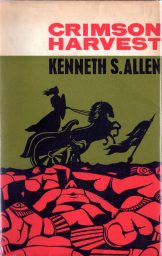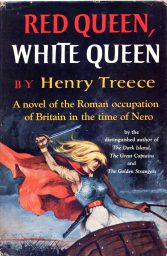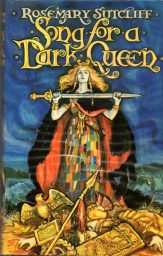Boudica, the Ultimate Brexiteer: In Fact and Fiction
Sunday , 29, January 2017 Uncategorized 7 CommentsThis is a guest post by my friend Richard Toogood, a lover of sword and sorcery fiction and history.
Boudica, the Ultimate Brexiteer: in fact and fiction
By
Richard Toogood
Part One: “Just the facts, ma’am”.
 With the United Kingdom on the cusp of beginning the formal process of disentangling itself from a federalising Europe it seems appropriate to consider a much earlier attempt at re-establishing Britain’s national sovereignty. Theresa May can intone “Brexit means Brexit” until the cows come home, but there was a previous female leader of the Britons for whom actions spoke louder than any words. One annihilated Roman legion, three incinerated towns and 70,000 massacred civilians establish Queen Boudica’s Brexit credentials beyond the scope of anyone to argue with.
With the United Kingdom on the cusp of beginning the formal process of disentangling itself from a federalising Europe it seems appropriate to consider a much earlier attempt at re-establishing Britain’s national sovereignty. Theresa May can intone “Brexit means Brexit” until the cows come home, but there was a previous female leader of the Britons for whom actions spoke louder than any words. One annihilated Roman legion, three incinerated towns and 70,000 massacred civilians establish Queen Boudica’s Brexit credentials beyond the scope of anyone to argue with.
Boudica remains a controversial and divisive figure to this day. To many she is a heroic warrior woman, a catalyst of independence and national resistance akin to the Cid of Spain. To others she is a psychotic war criminal and iconoclast little removed from your average Jihadi. Feminist icon on the one hand, deranged virago on the other. You makes your choices and you takes your pick.
What we can be certain of are the sparse grains of her life story which were preserved for us by the Roman historians Tacitus and Cassius Dio amidst the chaff of propaganda. Boudica was the wife of King Prasutagus of the Iceni. When Prasutagus died in AD 60 Boudica’s inheritance was stolen from her by the avaricious Roman Procurator Decianus Catus. When Boudica presumed to protest she found herself unceremoniously flogged and her daughters raped by Roman slaves. It was a heinous exhibition of boneheaded imperial greed and patrician stupidity and it was to reap the bitterest and bloodiest of harvests in reprisal. With the governor G.Suetonius Paulinus, and the bulk of the occupying Roman forces, absent in Wales massacring druids on the Isle of Anglesey Boudica was able to forge an alliance with the Trinovate tribe and rampage unopposed across the entire south east of Britain. The provincial capital of Camulodunum was razed to the ground and the town of Verulamium followed soon after. The hastily mustered ninth legion sent to intercept the Britons was ambushed and destroyed. The port of Londinium was then marched upon and obliterated. It was only when the returning Paulinus was able to draw the Britons into open pitched battle that superior Roman discipline and weaponry finally prevailed.
Of Boudica’s own fate history has left us no answer, apart from Tacitus’s supposition that she killed herself. What we can be certain of is the fact that she was never apprehended by the vengeful Paulinus. It is a sure bet that the Roman state, which she had shaken to its very foundations, would have reaped all the publicity it could from the example it would have made of her had he done so. But no such report has come down to us. With her rebellion comprehensively crushed Britannia went on to flourish as one of the Roman Empire’s more stable provinces.
have reaped all the publicity it could from the example it would have made of her had he done so. But no such report has come down to us. With her rebellion comprehensively crushed Britannia went on to flourish as one of the Roman Empire’s more stable provinces.
In the aftermath of her defeat Boudica’s name was lost to history for the next 1500 years. It was only during the early Tudor period that she was finally rediscovered. But it was the captivated Victorians who truly put her on a pedestal. Quite literally in fact in the case of Thomas Thorneycroft’s magisterial sculpture at the northern end of Westminster Bridge in London. It is utterly bizarre to consider that in the figure of Britannia which she inspired Boudica was used by the Victorians to personify the very concept of imperialism which she had resisted with such fortitude. It is ironic also, as the novelist Henry Treece observed, that a statue of her should preside over the very river that had once all but clotted with the blood of her victims.
Part Two: “When the truth becomes a legend…”
Since the turn of the millennium there has been something of a mini boom in Boudica fiction. Manda Scott’s trilogy is only the best known of many such examples. I am unable to offer a comment on the calibre of any of these books; I read modern fiction of any description only rarely and modern historical fiction almost never. Painful previous exposure has shown me that there are few practitioners nowadays capable of bringing the same sort of rich life experience to the task that was available to the many retired Colonels responsible for much of the best historical fiction of the past. Consequently this cursory overview is obliged to restrict itself to the golden age of 20th century historical writing which petered out around the turn of the 1980s. 
Although the Victorians were enthusiastic in their rediscovery of Boudica as a historical personage they proved less interested in employing such a threatening and powerfully independent woman in their popular fiction. Feminists would doubtless ascribe this squeamishness to their inheritance of her Roman enemies’ inherent misogyny.
It was only in the wake of the coronation of Queen Elizabeth the second that Boudica found a more receptive audience for her brand of primitive  female fury. It appears to be Boudica’s lot to enjoy her periodic resurgences only in the ascendency of similarly charismatic female leaders.
female fury. It appears to be Boudica’s lot to enjoy her periodic resurgences only in the ascendency of similarly charismatic female leaders.
To begin with Boudica’s rebellion was used more as a backdrop to – rather than the focus of – a succession of historical romances such as Anya Seton’s THE MISTLETOE AND THE SWORD (1955) and Henry Treece’s RED QUEEN, WHITE QUEEN (1958). As the 1960s progressed however so the personal stories of both Boudica and her nemesis Paulinus began to interest writers more and more. Both were to become the subject of everything from apologist hagiographies to scathing diatribes. George Shipway’s IMPERIAL GOVERNOR (1968) is arguably one of the finest historical novels ever produced. Written in the first person in the form of a memoir by the aging Paulinus it is a brilliant evocation both of the colonial mindset and the Roman military machine. Readers of the book may find themselves perplexed by the negligible nature of Boudica’s own contribution to the plot. But there is a perfectly sound reason for this. Despite their being inextricably linked by events it is doubtful in the extreme if Paulinus and Boudica ever actually met one another.
Generally speaking novelists have tended to take the part of either Boudica or Paulinus, depending on their personal agenda. Kenneth Allen’s CRIMSON HARVEST (1966) and J F Broxholme’s THE WAR QUEEN (1967) are interesting in that each attempts to tell the story of the uprising from both perspectives. Each gives Boudica just cause for her grievances but neither is blind to her savage excesses. THE GOLDEN CHARIOT (1979) by Philippa Wiat is more of an historical romance but doesn’t shy away from acknowledging the brutality either. All of these books are long out of print but are well worth sourcing from the second-hand market.
Surprisingly, considering the goriness of the narrative, Boudica’s story has been the subject of several juvenile novels also including Treece’s THE QUEEN’S BROOCH (1966) and Martin Mellett’s WARRIOR QUEEN (1978), the latter an adaptation of the Siân Phillips tv serial. Best of all is Rosemary Sutcliff’s elegiac SONG FOR A DARK QUEEN (1978) which is a magnificent evocation of an Iron Age culture in its end days.
Boudica was only able to fan the flames of her own personal grievances because the ground had been prepared for her by the Romans themselves. Contemptuous colonial policies of unmitigated migration, exorbitant taxation, land sequestration and supercilious meddling in tribal customs had inculcated a seething resentment among the natives which Boudica was able to exploit to her advantage. If the bureaucrats of the European Union had only bothered to study such cautionary precedents from the Roman Empire that they aspire to re-establish then perhaps they would not now be facing insurrections of their own and their own colonial edifice would not be on the point of collapse.

There was a series I read 30yrs ago that I’m pretty sure covered Boudica’s revolt. For the life of me, I can’t remember the series or the author, although it was a decent enough novel.
I’m guessing at this remove that the series covered the revolt because the book I read was about the subjection of Wales and Mona. Pretty solid writing on both the Brythons and Romans, as I recall.
Maybe not so bizarre the Victorians used Boudica. Don’t have time to try and find editorials or paens to Boudica from that time but thinking they used her for nationalistic purposes, such as the newly united Germans did with Arminius (https://infogalactic.com/info/Arminius).
That doesn’t mean this nationalism wasn’t used differently as Arminius can be viewed as a fighter against imperialism while Boudica may (key word is may) have been used as a boost to nationalism and pride, justifying spreading the benefits of enlightened British imperialism around the globe.
Forgot to add that it may not be bizarre but it is at least ironic.
Thanks for mentioning Sutcliff. I just looked up her stuff and she seems right up my alley.
-
Sutcliff is a really good author. Her EAGLE OF THE NINTH and SWORD AT SUNSET are both considered stone cold classics. Imagine Mary Stewart crossed with Poul Anderson with a little Keith Taylor thrown in.
I would love to see more guest posts like this. Maybe even a top 10 historical fiction.